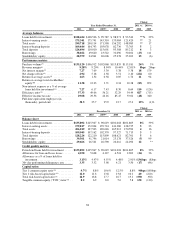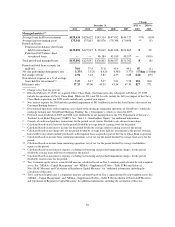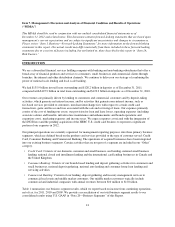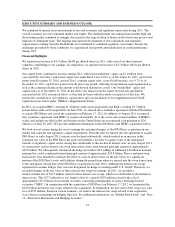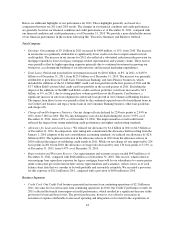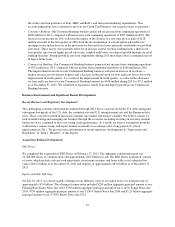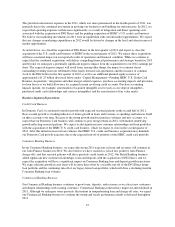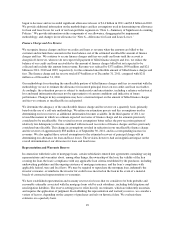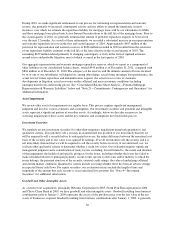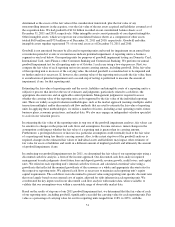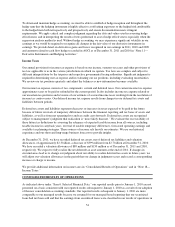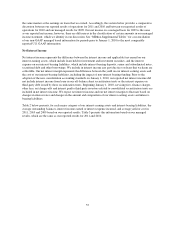Capital One 2011 Annual Report Download - page 67
Download and view the complete annual report
Please find page 67 of the 2011 Capital One annual report below. You can navigate through the pages in the report by either clicking on the pages listed below, or by using the keyword search tool below to find specific information within the annual report.The growth in non-interest expenses in the 2011, which was more pronounced in the fourth quarter of 2011, was
primarily due to the continued investment in growing our businesses and building our infrastructure. In 2012, we
expect that operating expenses will increase significantly as a result of integration and direct operating costs
associated with the acquisition of ING Direct and the pending acquisition of HSBC’s U.S. credit card business.
We believe our marketing investments in 2011 were in equilibrium with current market opportunities. We expect
that any changes in marketing expenditures in 2012 would be driven by changes in the level and attractiveness of
market opportunities.
As noted above, we closed the acquisition of ING Direct in the first quarter of 2012 and expect to close the
acquisition of the U.S. credit card business of HSBC in the second quarter of 2012. We expect these acquisitions
will have a material impact on our reported results of operations and financial condition. While we continue to
expect that the combined acquisitions will deliver compelling financial performance and strategic benefit in 2013
and beyond, we anticipate a potentially significant negative impact from the acquisitions to our 2012 earnings per
share. The expected negative impact will result from, among other things, the impact to common shares
outstanding resulting from our settlement of the equity forward sale agreements and the issuance of common
stock to the ING Sellers in the first quarter of 2012 as well as an additional planned equity issuance of
approximately $1.25 billion discussed below under “Capital Management—Pending HSBC U.S. Credit Card
Business Acquisition,” integration and other merger related expenses, purchase accounting impacts and provision
for loan losses as we build allowance for acquired current revolving credit accounts. Purchase accounting
impacts include, for example, amortization of acquired intangible assets (such as core deposit intangibles,
purchased credit card relationships and contract intangibles) and the amortization of fair value marks.
Business Segment Expectations
Credit Card Business
In Domestic Card, we returned to modest growth with expected seasonal patterns in the second half of 2011.
New account growth is a leading indicator of future growth in loans and revenues as spending and balances build
on these accounts over time. Because of the strong growth trends in purchase volumes and new accounts, we
expect that our Domestic Card business will continue to post strong returns in 2012, with modest underlying
growth reflecting seasonal patterns. We expect to add significant new customer relationships and loan portfolios
with the acquisition of the HSBC U.S. credit card business, which we expect to close in the second quarter of
2012. After this initial increase in loan volumes, the HSBC U.S. credit card business acquisition may diminish
our Domestic Card growth trajectory due to the expected run-off of portions of the HSBC credit card portfolio.
Consumer Banking Business
In our Consumer Banking business, we expect the strong 2011 trajectory in loans and revenues will continue in
our Auto Finance business in 2012. We also believe we have reached a cyclical low point for Auto Finance
charge-offs, and that seasonal patterns will drive quarterly credit trends in 2012. Our Retail Banking business
added significant new customer relationships, loans and deposits with the acquisition of ING Direct, and we
expect the acquisition will have a significant impact on Consumer Banking loan and deposit growth trajectories.
We expect that the growth in auto loans will be more than offset by a sizeable run-off of the ING Direct home
loan portfolio and the continuing run-off of our legacy home loan portfolio, which will drive a declining trend in
Consumer Banking loan volumes.
Commercial Banking Business
Our Commercial Banking business continues to grow loans, deposits, and revenues as we attract new customers
and deepen relationships with existing customers. Commercial Banking credit metrics improved and stabilized in
2011. Although we anticipate some quarterly fluctuations in nonperforming loan and charge-off rates, we expect
our Commercial Banking business to continue the strong and steady performance trends it delivered throughout
2011.
47



